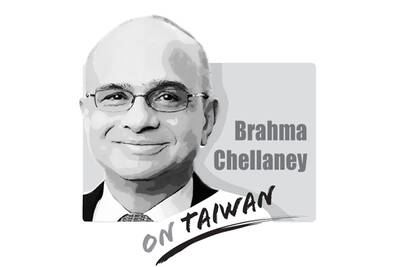Now that President Ma Ying-jeou (馬英九) has been in power for a few months, one would have hoped that a clearer picture of his vision for the nation would emerge.
Sadly, this has not happened.
The one thing that is certain is that the Ma government is committed to maintaining the “status quo,” which means perpetrating the “one China” formula — with or without the 1992 fig leaf of ambiguous interpretation.
With the “status quo” mantra in place, the administration has hoped to create relative stability in cross-strait relations. This, in turn, is supposed to lead to quantitative improvements in economic relations in all sectors that have benefits for all Taiwanese.
So far, though, the anticipated hike in economic indicators, such as the stock market, has not materialized, which is causing the government considerable embarrassment.
In other words, all the fanfare over instant nirvana from stable cross-strait relations was empty hype.
Unless the Ma government has given up on Taiwan’s sovereignty, it is certainly heading in the wrong direction in conducting its relations with China.
An important principle of international diplomacy is not to show all one’s cards when conducting formal or informal relations.
But the Ma administration has acted in such unseemly haste that its emissaries and officials have appeared ecstatic to have been received in Beijing in any capacity.
The whole exercise has been undignified and one-sided, with Taiwan looking like a supplicant.
The Ma administration has therefore lost whatever leverage it once had to fashion its relations with Beijing to its advantage. It seems to think that opening and expanding economic and other ties with China will catapult Taiwan to new levels of prosperity.
But this is not happening, which means that the Ma government will grow more preoccupied with bridging the gap between rhetoric and reality.
The worst thing is that, having pinned all its expectations on Beijing, the government will likely find it hard to regain lost ground.
In the meantime, the US’ commitment to defend Taiwan is languishing. Of course, a US commitment to help Taiwan remains. But where are the new weapons to defend against China’s military machine?
The Taiwan-US relationship is caught in a complex tangle involving US hesitancy to complicate relations with China over Taiwan. Amid a background of Washington’s overstretched military and years of Chinese Nationalist Party (KMT) obstruction of arms bills, the Ma government’s ambiguous position on Taiwan’s final status only exacerbates Taiwan’s vulnerability.
The Ma administration’s ability to defend Taiwan is being compromised as Beijing applies the screws through likeminded elements in the KMT.
At the same time, Taiwan’s international space is likely to shrink further as allies gain the impression that the Ma regime is now more aligned with China.
Taiwan was already having serious problems expanding its international space via membership of international organizations and fostering relations with other states. But if Ma thought that Beijing would assist Taiwan in expanding its international space simply because a KMT government had been elected, then he was deluded.
The KMT has no clear idea where it is going, other than making every effort to impress Beijing with its cooperativeness.
Taiwan is therefore in dire straits —assuming its people value their political identity and sovereignty.
It is time those who do value such things wake up and energize their political institutions to meet this grim challenge.
Sushil Seth is a writer based in Australia.

As strategic tensions escalate across the vast Indo-Pacific region, Taiwan has emerged as more than a potential flashpoint. It is the fulcrum upon which the credibility of the evolving American-led strategy of integrated deterrence now rests. How the US and regional powers like Japan respond to Taiwan’s defense, and how credible the deterrent against Chinese aggression proves to be, will profoundly shape the Indo-Pacific security architecture for years to come. A successful defense of Taiwan through strengthened deterrence in the Indo-Pacific would enhance the credibility of the US-led alliance system and underpin America’s global preeminence, while a failure of integrated deterrence would
It is being said every second day: The ongoing recall campaign in Taiwan — where citizens are trying to collect enough signatures to trigger re-elections for a number of Chinese Nationalist Party (KMT) legislators — is orchestrated by the Democratic Progressive Party (DPP), or even President William Lai (賴清德) himself. The KMT makes the claim, and foreign media and analysts repeat it. However, they never show any proof — because there is not any. It is alarming how easily academics, journalists and experts toss around claims that amount to accusing a democratic government of conspiracy — without a shred of evidence. These
Taiwan is confronting escalating threats from its behemoth neighbor. Last month, the Chinese People’s Liberation Army conducted live-fire drills in the East China Sea, practicing blockades and precision strikes on simulated targets, while its escalating cyberattacks targeting government, financial and telecommunication systems threaten to disrupt Taiwan’s digital infrastructure. The mounting geopolitical pressure underscores Taiwan’s need to strengthen its defense capabilities to deter possible aggression and improve civilian preparedness. The consequences of inadequate preparation have been made all too clear by the tragic situation in Ukraine. Taiwan can build on its successful COVID-19 response, marked by effective planning and execution, to enhance
Since taking office, US President Donald Trump has upheld the core goals of “making America safer, stronger, and more prosperous,” fully implementing an “America first” policy. Countries have responded cautiously to the fresh style and rapid pace of the new Trump administration. The US has prioritized reindustrialization, building a stronger US role in the Indo-Pacific, and countering China’s malicious influence. This has created a high degree of alignment between the interests of Taiwan and the US in security, economics, technology and other spheres. Taiwan must properly understand the Trump administration’s intentions and coordinate, connect and correspond with US strategic goals.